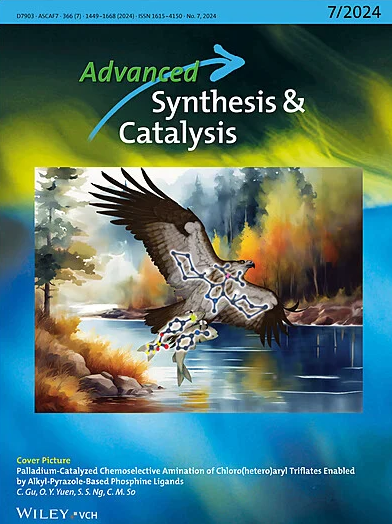Ligand controlled regio‐divergent [2+2+2] cyclotrimerization of alkynes by merging electrochemistry and nickel catalysis
IF 4.4
2区 化学
Q2 CHEMISTRY, APPLIED
引用次数: 0
Abstract
Transition metal catalyzed [2+2+2] cycloaddition reactions between three alkynes, a diyne and an alkyne, or a triyne offer a straightforward and typical protocol toward all kinds of polysubstituted benzens. Herein, the synthesis of polysubstituted aromatics through electrochemical nickel catalyzed cyclotrimerization of alkynes is developed. The regio‐divergent cyclotrimerization of terminal alkynes was achieved by judicious choice of ligands. And tributylphosphine, sterically hindered bipyridine or β‐diketone ligands delivered 1,2,4‐ and 1,3,5‐substituted aromatics with high regioselectivities respectively. Besides, the semi‐intermolecular [2+2+2] cycloaddition between diynes and alkynes are also amenable under this catalytic system. This approach operates without metal reductant, exhibits wide functional groups tolerance, ease of scalability and furnishes 75 examples with moderate to good yields, including some biorelevant compounds. Mechanistic experiments and DFT calculation revealed the catalytic pathways of 1,3,5‐ and 1,2,4‐cyclotrimerizations, and the origin of the ligand controlled regioselectivity.求助全文
约1分钟内获得全文
求助全文
来源期刊

Advanced Synthesis & Catalysis
化学-应用化学
CiteScore
9.40
自引率
7.40%
发文量
447
审稿时长
1.8 months
期刊介绍:
Advanced Synthesis & Catalysis (ASC) is the leading primary journal in organic, organometallic, and applied chemistry.
The high impact of ASC can be attributed to the unique focus of the journal, which publishes exciting new results from academic and industrial labs on efficient, practical, and environmentally friendly organic synthesis. While homogeneous, heterogeneous, organic, and enzyme catalysis are key technologies to achieve green synthesis, significant contributions to the same goal by synthesis design, reaction techniques, flow chemistry, and continuous processing, multiphase catalysis, green solvents, catalyst immobilization, and recycling, separation science, and process development are also featured in ASC. The Aims and Scope can be found in the Notice to Authors or on the first page of the table of contents in every issue.
 求助内容:
求助内容: 应助结果提醒方式:
应助结果提醒方式:


